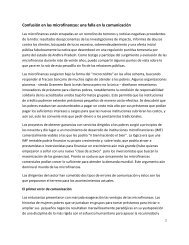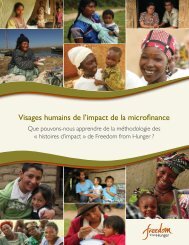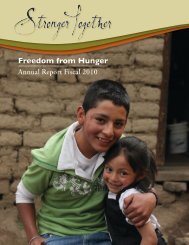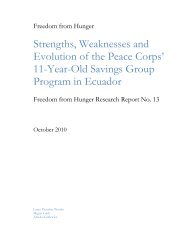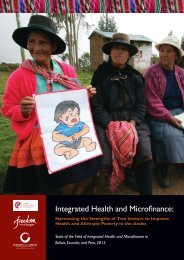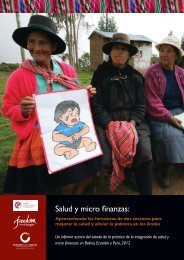history of meals for millions, soy, and freedom from ... - SoyInfo Center
history of meals for millions, soy, and freedom from ... - SoyInfo Center
history of meals for millions, soy, and freedom from ... - SoyInfo Center
You also want an ePaper? Increase the reach of your titles
YUMPU automatically turns print PDFs into web optimized ePapers that Google loves.
306. Kuzins, Rebecca. 1984. Clif<strong>for</strong>d Clinton’s food<br />
fantasies: You could safely say he’s fed more people than<br />
anybody but the army. He’s provided, so to speak, Meals <strong>for</strong><br />
Millions. Los Angeles Reader 6(18):1, 8-13. Feb. 24.<br />
• Summary: A long, excellent overview article. Sometime<br />
during World War II, on a typical workday in downtown<br />
Los Angeles, you come trudging down Olive Street until<br />
you “reach a building at 618 S. Olive St. that, by only the<br />
utmost understatement, could be described as ‘unusual.’ A<br />
waterfall runs down <strong>from</strong> the ro<strong>of</strong> a few feet toward a<br />
collection <strong>of</strong> rocks <strong>and</strong> foliage above the door. Smaller<br />
waterfalls <strong>and</strong> other trees <strong>and</strong> rocks are placed on either side<br />
<strong>of</strong> the central waterfall.<br />
“Once inside you see a tropical decor many times more<br />
garish than the scene that accosted you on the street. You<br />
can sit at table among caged canaries, a dozen more<br />
waterfalls, <strong>and</strong> gigantic palm trees. The walls are sheathed<br />
in bamboo <strong>and</strong> the place is lit by neon lights in the shape <strong>of</strong><br />
lilies <strong>and</strong> other flowers. Daring guests sit in a rain hut where<br />
a simulated monsoon is recreated every 20 minutes.”<br />
“This is actually a cafeteria, but you’d never guess it,<br />
because the path to the food counter is a long, dark cavern<br />
in back <strong>of</strong> the building, illuminated only by lighting <strong>from</strong><br />
fish tanks placed along the path.<br />
You’re right–this is not just any cafeteria. It’s Clifton’s<br />
Pacific Seas Cafeteria, a legendary eatery that has staked<br />
out its place in the city’s <strong>history</strong>.” But in 1960 it was<br />
demolished to make room <strong>for</strong> a parking lot. Two years ago,<br />
when the writer started conducting tours <strong>of</strong> Broadway, she<br />
found that as they walked past the place where Pacific Seas<br />
used to be, her “charges would describe with perfect clarity<br />
<strong>meals</strong> they ate 30-40 years ago at Clifton’s. Their interest in<br />
Clifton’s piqued my curiosity <strong>and</strong> led me on a year-long<br />
odyssey into the heart <strong>of</strong> the cafeteria.” In the process she<br />
“came to know one <strong>of</strong> Los Angeles’s truly great promoters–<br />
the late Clif<strong>for</strong>d E. Clinton, the founder <strong>of</strong> the chain <strong>of</strong><br />
restaurants bearing a composite <strong>of</strong> his first <strong>and</strong> last names.<br />
Clinton understood as well as anyone that Los Angeles is<br />
one part reality <strong>and</strong> the rest pure invention.<br />
“‘He was trying to do something way out <strong>of</strong> the<br />
ordinary,’ said his youngest son, Donald Clinton, who, with<br />
his sister Jean Clinton Roeschlaub, now owns the Clifton<br />
Cafeteria chain.<br />
“‘This was be<strong>for</strong>e Disneyl<strong>and</strong>,’ agreed Jean. ‘He was<br />
trying to make something memorable, something to appeal<br />
to tourists.’<br />
“Clif<strong>for</strong>d was born into the restaurant business. His<br />
gr<strong>and</strong>father, David Harrison Clinton, arrived in Los Angeles<br />
in 1888 <strong>and</strong> soon purchased the dining room <strong>of</strong> the old<br />
Pacific Hotel. David’s son, Edmond, moved to San<br />
Francisco, where he <strong>and</strong> his wife Gertrude, became owners<br />
<strong>of</strong> a chain <strong>of</strong> dining rooms called Dennets. Edmond <strong>and</strong><br />
Gertrude had nine children, including Clif<strong>for</strong>d, who was<br />
born in Berkeley on August 3, 1900.<br />
MEALS FOR MILLIONS, SOY, AND FREEDOM FROM HUNGER 135<br />
© Copyright Soyinfo <strong>Center</strong> 2011<br />
“In what became a significant event in young Clif<strong>for</strong>d’s<br />
life, his parents temporarily left the restaurant business to<br />
become Salvation Army missionaries in China. Clif<strong>for</strong>d was<br />
ten years old when his family made the trip; they stayed <strong>for</strong><br />
two years. He would later say the sight <strong>of</strong> starving Chinese<br />
people remained in his mind all <strong>of</strong> his life, pr<strong>of</strong>oundly<br />
affecting the way he conducted his business.<br />
“Returning the United States in 1912, Edmond Clinton<br />
opened another chain <strong>of</strong> cafeterias in San Francisco called<br />
Clintons. Clif<strong>for</strong>d Clinton left high school in 1915 to be<br />
storekeeper one <strong>of</strong> the restaurants, rising to supervising<br />
manager <strong>of</strong> all six restaurants by 1925. He eventually<br />
became one <strong>of</strong> the three partners <strong>of</strong> the Clinton Cafeteria<br />
Co., though Clinton differed with his partners on how to<br />
best manage the business.<br />
“‘His ideas were just a little to wild <strong>for</strong> San Francisco,’<br />
said Jean Clinton Roeschlaub. ‘His partners were more<br />
conservative <strong>and</strong> they <strong>for</strong>ced him out <strong>of</strong> the business.’<br />
“San Francisco’s loss was Los Angeles’s gain. Moving<br />
here in 1931, Clinton found the perfect city in which to<br />
enact his cafeteria fantasies.<br />
Note: The word “cafeteria” is Spanish <strong>for</strong> “c<strong>of</strong>fee<br />
shop.” Some, including the writer, claim that Los Angeles is<br />
the home <strong>of</strong> the cafeteria or <strong>of</strong> the “modern cafeteria;” she<br />
cites two sources. But the majority opinion disagrees.<br />
In 1931 Clif<strong>for</strong>d Clinton purchased what was already a<br />
cafeteria at 618 S. Olive St. According to Jean Clinton<br />
Roeschlaub it already “‘had a couple <strong>of</strong> palm trees <strong>and</strong> a<br />
little fountain in the dining room. But in no way did it<br />
resemble what my father did with the 1939 remodeling.’”<br />
Clinton “could not have picked a less opportune time,<br />
<strong>for</strong> the city was beginning to feel the effects <strong>of</strong> the<br />
Depression... Clinton responded to the economic situation<br />
with a combination <strong>of</strong> evangelical zeal <strong>and</strong> business<br />
acumen. He dubbed the business ‘The Cafeteria <strong>of</strong> the<br />
Golden Rule.’” He established a policy that no guest would<br />
be turned away hungry <strong>for</strong> lack <strong>of</strong> funds. But during the<br />
Depression this policy made it hard <strong>for</strong> the restaurant to run<br />
pr<strong>of</strong>itably. Moreover, as Donald Clinton recalls: “‘Many <strong>of</strong><br />
these people were dirty, drunk <strong>and</strong> smelly <strong>and</strong> it wouldn’t be<br />
right <strong>for</strong> them to sit down with paying guests. My dad was<br />
enough <strong>of</strong> a realist to know there were going to be<br />
problems.’<br />
“Clinton solved this problem by opening the Penny<br />
Cafeteria in the basement <strong>of</strong> a building at Second <strong>and</strong> Hill<br />
streets on October 10, 1932. Patrons at his Olive Street store<br />
could purchase tickets <strong>for</strong> a penny a piece <strong>and</strong> h<strong>and</strong> these<br />
tickets to a hungry person who would stop them on the<br />
street. For the price <strong>of</strong> a ticket, a diner at the Penny<br />
Cafeteria received a complete meal <strong>from</strong> soup to dessert.<br />
Merchants donated produce, meat, <strong>and</strong> day-old bread to the<br />
project. The Penny Cafeteria closed after two years but<br />
Clinton continued to serve nickel <strong>and</strong> quarter <strong>meals</strong> to<br />
needy persons throughout the thirties.”



